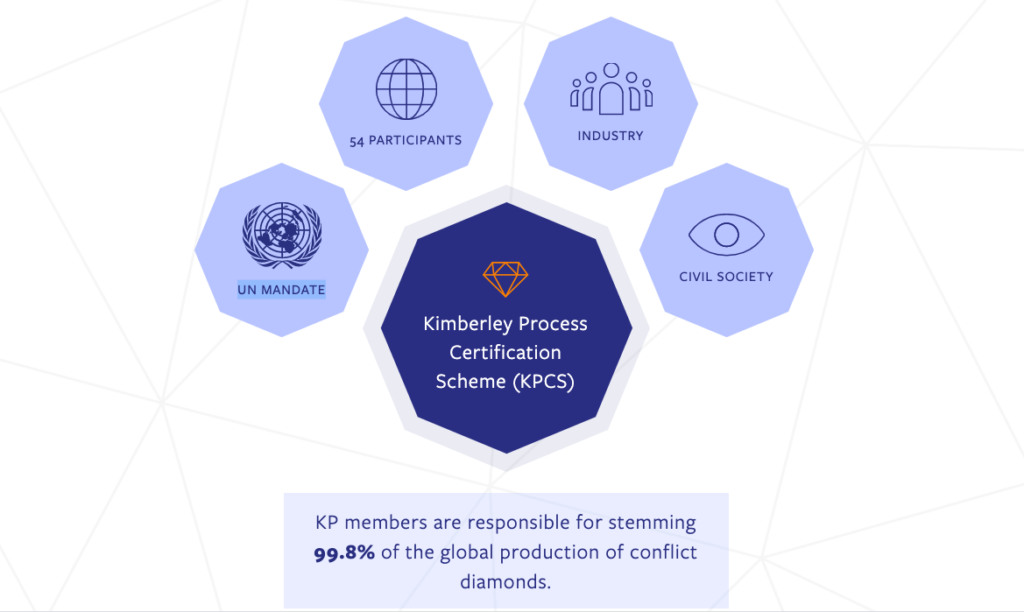Part
01
of one
Part
01
Diamonds Mapping and Tracking Overview
Key Takeaways:
- The "Kimberly Process (KP) is an international, multi-stakeholder initiative" developed to increase oversight and transparency in the diamond industry so as to eliminate the trade of conflict diamonds.
- Since many customers are now looking beyond sourcing and are demanding proof that diamonds were also refined ethically, many industry players are turning to blockchain to change the 'opaque nature' of the industry.
- The need for traceability has transformed the diamond industry compelling market players to seek more reliable ways to communicate each diamond's provenance.
Introduction:
- This report provides an overview of how diamonds are mapped and tracked. The report has highlighted two ways of diamond mapping. It has also provided insights into the importance of mapping.
Summary of Findings
Process of Diamond Mapping
- Each rough diamond is as unique as a human fingerprint, which enables traceability. There are several ways that diamonds can be mapped, as explained below.
The Kimberly Process
- Operational since 2003, the "Kimberly Process (KP) is an international, multi-stakeholder initiative" developed to increase oversight and transparency in the diamond industry so as to eliminate the trade of conflict diamonds. KP controls the diamond trade between participating countries by implementing a domestic certification scheme and prohibiting transactions with non-participants.
- Rough diamonds from the 82 participating countries must be transported in sealed containers and exported with a KP Certificate certifying that they have not benefitted rebel groups.
Blockchain
- The KP has been criticized for not encompassing other human rights violations that take place throughout the supply chain. Since many customers are now looking beyond sourcing and are demanding proof that diamonds were also refined ethically, many industry players are turning to blockchain to change the 'opaque nature' of the industry. Blockchain technology provides a more detailed perspective of the diamond's journey from source to market.
- Several key players are developing technologies in an effort to enhance traceability, among them De Beers and Alrosa. Here is an example of how De Beers, in collaboration with other industry players, is leveraging blockchain technology to counter theft and counterfeiting while improving the reputation of their products.
De Beers' Tracr
- Apart from struggling with counterfeiting and theft of diamonds, the industry has suffered from being associated with forced labor, which has increased the preference for lab-grown diamonds. De Beers is turning to blockchain to not only increase the security of its supply chain but also provenance and authenticity. Leveraging blockchain will enable it to tell the diamond's story from the miner to the customer.
- The newly-developed technology, Tracr, maps millions of points of a stone to form a virtual replica of the physical stone. The image, as well as other characteristics of the stone such as the weight and size, are logged onto the system to complete the digital twin. Additional data such as the mine site and owner are also recorded.
- Being that rough diamonds are usually cut into smaller pieces, Tracr uses algorithms that "can take multiple scans along the value chain and verify them back to the original stone." Scans of the diamond through the planning and cutting process are sent to the cloud and used to match it through the process. Notably, apart from the declarative statement, verification is conducted at each point of the supply chain.
Importance of Diamond Tracing
- The need for traceability has transformed the diamond industry compelling market players to seek more reliable ways to communicate each diamond's provenance. The increasing buying power of younger customers is forcing the industry to align with their social responsibility expectations by developing innovative solutions for increasing transparency in the supply chain while enhancing the purchasing experience. Gen Z and Millennial buyers, who drive most of the global diamond jewelry demand, require details regarding the authenticity, provenance, and history of diamonds.
- According to Paul Zimnisky, a leading diamond Analyst, effective diamond traceability can alleviate most challenges that the diamond industry has faced in recent years. It enables the consumer to know that the diamond is natural, real, and conflict-free. Also, "the diamond comes with its own story in a time when consumers want to express uniqueness and want to have a story to tell about their most special possessions."
Research Strategy
To provide the required information on diamond mapping and tracking, the research team leveraged credible sources such as the Chartered Institute of Procurement and U.S. government publications. We also used publications from industry players such as QReport and Sarine.
